Part XI of the Indian Constitution outlines the framework for Centre-State administrative relations through Articles 256 to 263, along with other related provisions. This framework clarifies the distribution of executive powers, obligations, and the mechanisms for mutual delegation between the Central and State governments. Understanding these elements is crucial for appreciating how administrative functions are managed and coordinated in India’s federal structure.
Administrative Relations in the Indian Constitution
Distribution of Executive Powers
- Allocation of Executive Power: The allocation of executive power between the Central government and the States of India generally mirrors the distribution of legislative power, with some exceptions.
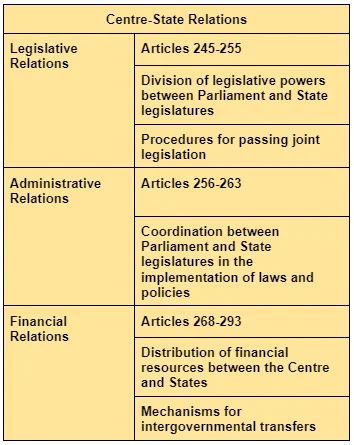
-
- Union List Subjects: The Central government holds executive authority over matters enumerated in the Union List, which includes subjects such as defence, foreign affairs, currency, and interState trade.
- Treaty and Agreement-Based Rights: The Central government exercises executive power in areas where it has been granted rights, authority, or jurisdiction through treaties or agreements.
- State Government’s Executive Authority: Within their respective territories, State governments hold executive power over matters listed in the State List, which includes subjects such as education, public health, agriculture, and local government.
- Executive Power in Concurrent Subjects: For matters on which both the Parliament and the State legislatures have power of legislation (i.e., the subjects enumerated in the Concurrent List),
- The executive power primarily rests with the States.
- However, a constitutional provision or a Parliamentary law may specifically confer executive power on the Central government in certain instances.
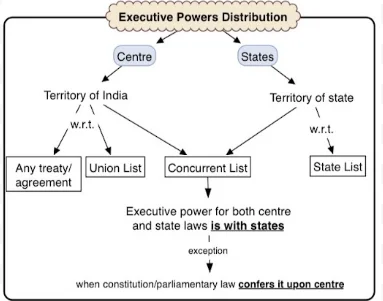
Enroll now for UPSC Online Course
- Summary of Executive Power Division in India’s Federal Structure
-
- Federal Structure Reflection: The division of executive power between the Central government and the States reflects the federal structure of India, with each level of government having its own sphere of authority.
- Effective Management and Administration: This distribution of power ensures that both the Central and State governments can effectively manage and administer their respective areas of responsibility.
Obligation of States and the Centre
- Restrictions on State Executive Power: The Indian Constitution imposes two restrictions on the executive power of the States to ensure that the Central government has ample room for the unrestricted exercise of its executive power.
- Compliance with Central Laws: Every State’s executive power must be exercised in a manner that adheres to the laws enacted by the Parliament and any other applicable laws.
- This general obligation ensures that States’ actions align with the overarching framework established by the Central government.
- Non-interference with Central Executive Power in States: States must exercise their executive power in a way that does not hinder or prejudice the Central government’s exercise of executive power within their territory.
- This specific obligation ensures that State actions do not obstruct the Central government’s ability to fulfil its national responsibilities.
- Compliance with Central Laws: Every State’s executive power must be exercised in a manner that adheres to the laws enacted by the Parliament and any other applicable laws.
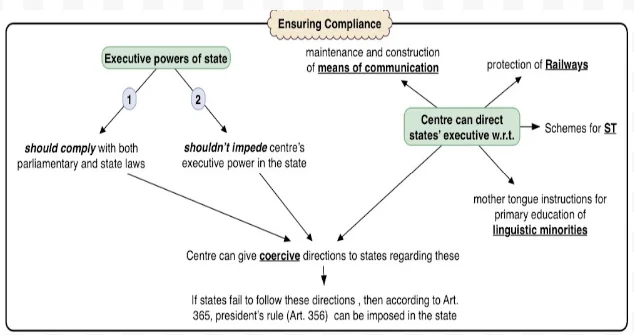
- Central Government’s Power To Issue Directions: In both instances where State executive power is subject to restrictions, the Central government has the authority to issue directions to the concerned State.
- These directions are coercive in nature, meaning that the State is legally bound to comply.
- Enforcement of Central Directions: Article 365 empowers the President to declare a situation where the government of a State cannot be carried on in accordance with the Constitution if the State fails to comply with or give effect to any directions issued by the Central government.
- In such circumstances, the President can impose the President’s rule under Article 356, assuming control of the State’s administration until the situation is rectified.
- Safeguarding Central Responsibilities: In essence, these constitutional provisions safeguard the Central government’s ability to fulfil its responsibilities and maintain national unity while allowing the States to exercise their executive power within their respective spheres.
Centre’s Directions to the States
- Authority of the Centre to Issue Directives to States: Apart from the two scenarios mentioned earlier, the Central government has the authority to issue directives to the States regarding the exercise of their executive power in the following situations:
- Construction and Maintenance of National or Military Communication Networks
- When a State undertakes the construction or maintenance of communication infrastructure deemed crucial for national or military purposes, the Central government can provide guidance and directives.
- Protecting Railways within the State
- The Central government can issue directives to States regarding measures necessary to safeguard railways within their territories.
- Education in Mother Tongue for Linguistic Minority Groups
- To ensure that children belonging to linguistic minority groups receive adequate primary education in their mother tongue, the Central government can direct States to implement specific schemes.
- Welfare Schemes for Scheduled Tribes
- The Central government can issue directives to States regarding the formulation and execution of designated programs aimed at promoting the welfare of Scheduled Tribes.
- Construction and Maintenance of National or Military Communication Networks
- Enforcement Mechanism Under Article 365: The coercive enforcement mechanism outlined in Article 365, as mentioned earlier, also applies in these instances.
- This means that if a State fails to comply with or give effect to any directions issued by the Central government in these matters, the President may invoke Article 356 to impose President’s rule in that State.
Mutual Delegation of Functions
- Rigidity in the Division of Legislative Powers: The division of legislative powers between the Centre and the States in India is characterised by rigidity.
- This means that the Centre cannot delegate its legislative powers to the States, and individual States cannot request the Parliament to enact laws on matters falling under the State List.
- Flexibility in the Distribution of Executive Powers:
- Alignment of Executive and Legislative Powers: In contrast, the distribution of executive power generally aligns with the distribution of legislative power.
- Potential Conflicts Due to Rigidity: However, the rigid nature of this division can sometimes lead to conflicts between the two levels of government.
- Constitutional Provision for Delegation: To address this issue and prevent situations of deadlock, the Constitution provides for inter-governmental delegation of executive functions.
- Promoting Flexibility and Cooperation: This mechanism allows for flexibility and cooperation between the Central government and the States in the execution of administrative responsibilities.
| Feature | Legislative Power | Executive Power |
| Distribution | Rigid | Generally follows legislative power distribution |
| Flexibility | Limited | Inter-governmental delegation of executive functions |
| Purpose | Prevent encroachment on legislative spheres | Mitigate rigidity and avoid deadlock |
- Inter-Governmental Delegation in Balancing Power: The inter-governmental delegation of executive functions serves as a crucial tool in maintaining a balance between the Central government and the States.
- Efficiency and Effectiveness: It allows for a more efficient and effective administration of government affairs, ensuring that both levels of government can contribute to the overall well-being of the nation.
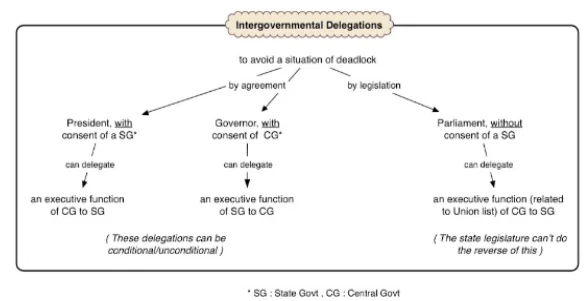
- Mechanisms for Delegating Executive Functions: The Indian Constitution provides for two mechanisms for delegating executive functions between the Central government and the States: mutual agreements and legislative delegation.
- Mutual Agreements:
- Presidential Delegation to State: The Constitution enables the President, with the consent of the State government, to entrust any of the Central government’s executive functions to that State government.
- Gubernatorial Delegation: Conversely, the Governor of a State may, with the consent of the Central government, entrust any of the State’s executive functions to the Central government.
- Conditional or Unconditional Delegation: This mutual delegation of administrative functions can be conditional or unconditional.
- Legislative Delegation:
- Parliament’s Authority to Confer Powers: The Parliament can enact laws that confer powers and impose duties on a State, or authorise the Central government to confer powers and impose duties on a State, regardless of the State’s consent.
- Limitations on State Legislatures’ Authority: State legislatures cannot confer powers or impose duties on the Central government through legislation.
- Summary of Delegation Mechanisms: In summary, the Central government can utilise both mutual agreements and legislative delegation to delegate executive functions to the States.
- However, States can only delegate executive functions to the Central government through mutual agreements.
- This distinction reflects the Central government’s broader authority in the legislative sphere.
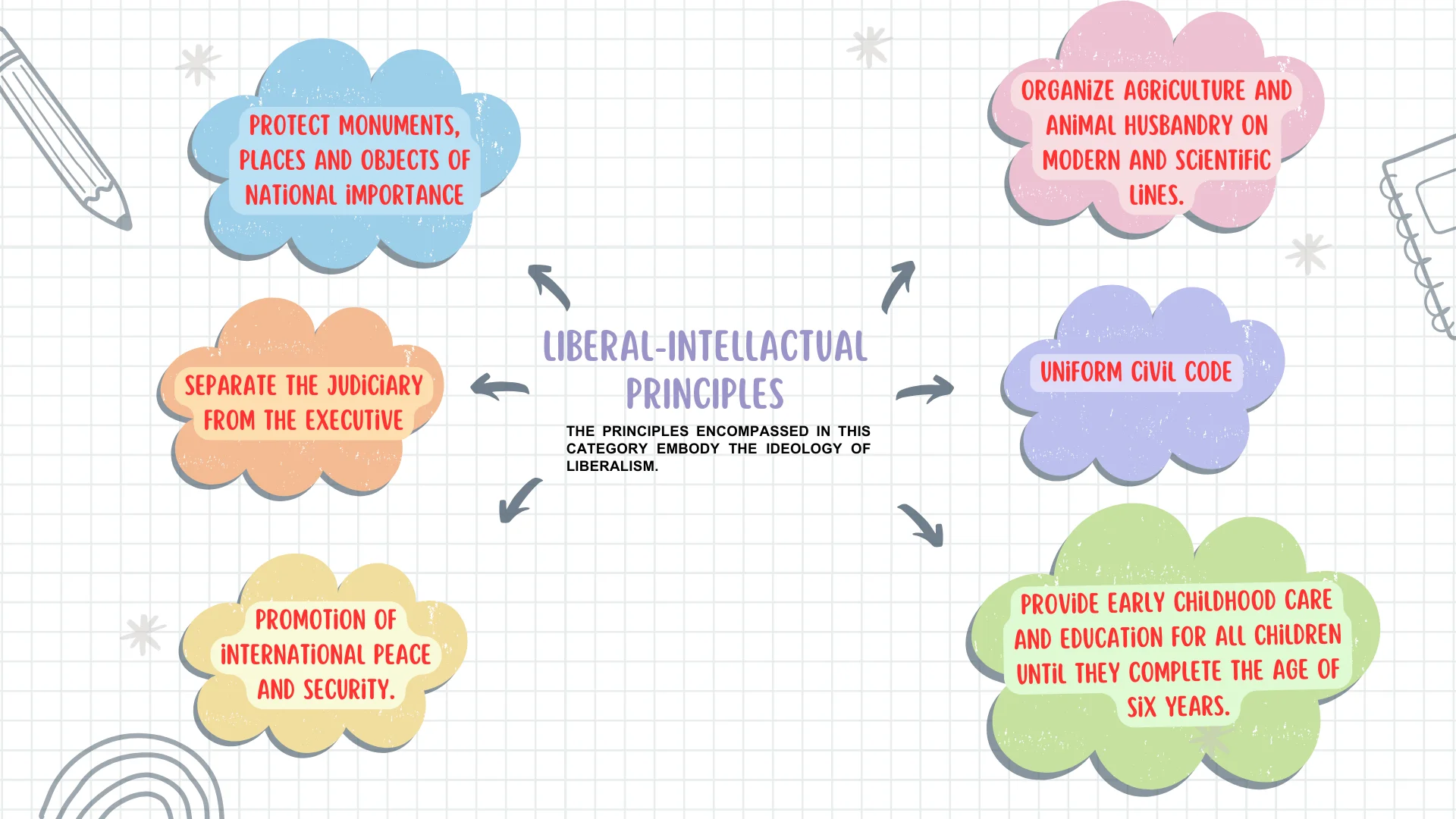
Enroll now for UPSC Online Course
| Must Read | |
| Current Affairs | Editorial Analysis |
| Upsc Notes | Upsc Blogs |
| NCERT Notes | Free Main Answer Writing |
Conclusion
The administrative relations defined by the Indian Constitution ensure a structured balance of power between the Centre and the States.
- Through clear delineation of executive powers and mutual delegation mechanisms, the Constitution fosters cooperation while respecting each government’s domain.
- This framework helps manage administrative functions efficiently and maintains harmony within India’s federal system.
Sign up for the PWOnlyIAS Online Course by Physics Wallah and start your journey to IAS success today!
| Related Articles | |
| Centre State Administrative Relations (Articles 256-263) in India | Features of Indian Constitution |
| Legislative Procedure In State Legislature | Federalism |

 GS Foundation
GS Foundation Optional Course
Optional Course Combo Courses
Combo Courses Degree Program
Degree Program












